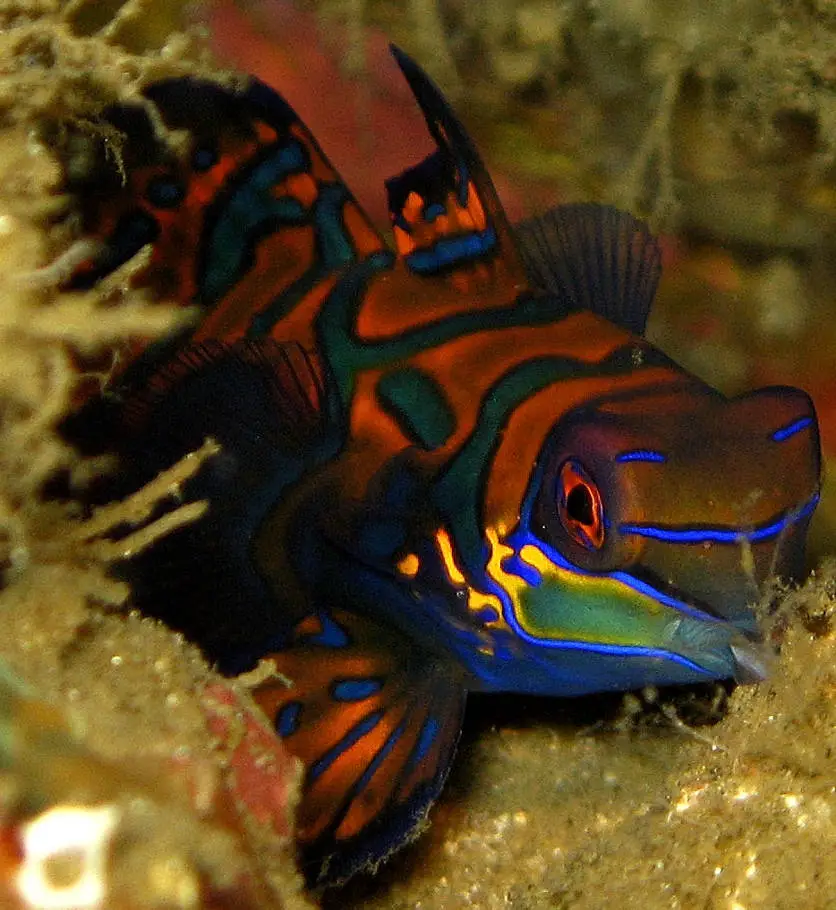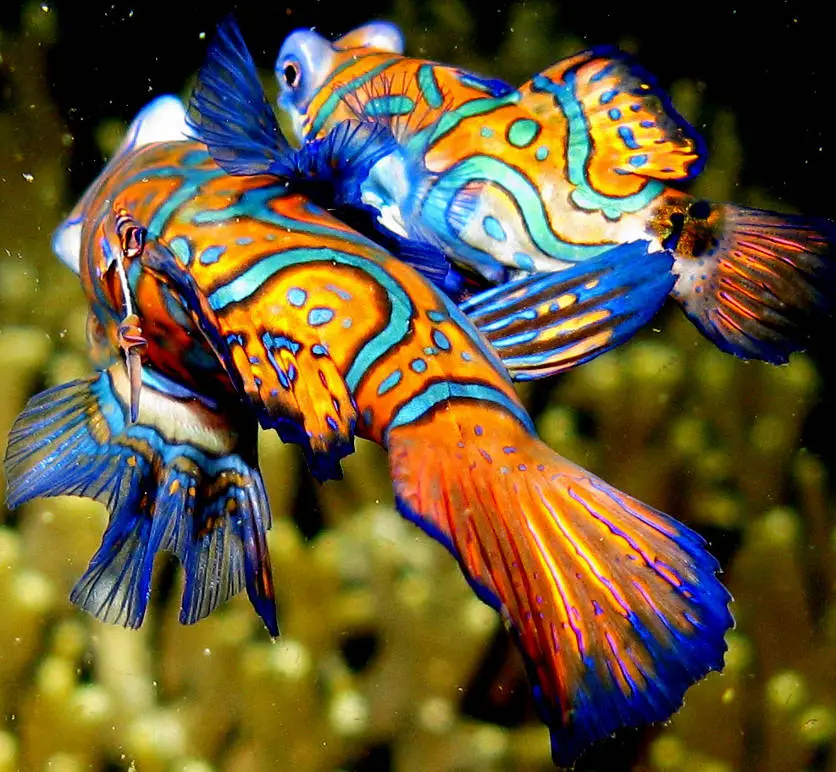Synchiropus cf. splendidus
| Difficulty | High |
| Minimum Tank Size | Variable, See Feeding Section |
| Diet | Carnivore |
| Water Parameters | 72-78 F, pH 8-8.4, Salinity 1.020-1.025 |
| Aggression | Aggressive only towards other mandarins |
| Size | 4" |
Red Mandarin gobys, also known as dragonets, are truly the dragon of the sea. Their eye catching colors, arranged in extravagant patterns, combined with their humorous personalities are an amazing addition to tanks.
Mandarins always sport a high difficulty due to their picky diet. Unless trained properly Red Mandarin gobies will refuse to eat anything but copepods and amphipods, which are tiny crustaceans that hide in live rock, macro algae and substrate. Mandarins are considered bottom dwellers yet will spend plenty of time climbing the rocks and glass searching for food.

Feeding & Diet
As previously stated, Red Mandarins rely heavily on copepods and amphipods thriving in the tank. That being said Mandarins are typically limited to larger systems of 50+ gallons per mandarin. Even in these cases a single mandarin can hunt the pod population into extinction.
A common method for housing mandarins is to learn how to culture copepods. The main problem is when a culture crashes it can take a long time to revive, with new cultures taking a few weeks to start. Multiple cultures should be run at all times when using this method.
These methods make mandarin keeping a difficult task, especially when housing more than one. To combat this many mandarin owners will train the Red Mandarin goby to eat prepared foods. This is best done in an isolation or hospital tank.
Feeding Frozen/Prepared Foods
To train Red Mandarins to eat frozen foods you will need:
- Copepods
- Live Brine Shrimp
- Frozen Brine Shrimp
- Frozen Mysis Shrimp OR Pellets
- Feeding Device
While the feeding device is not needed for training, it will make feeding the mandarin in a display tank much easier. Red Mandarins are slow hunters and cannot deal with food competition, making the training pointless without a feeding device. This can be as simple as a turkey baster or as complex as a feeding pad.
Mandarins eat by searching the tank for food, often hopping about on the glass, substrate or live rock. During this time they use their amazing eye sight to search for pods before striking. The same attitude will be taken for frozen and prepared foods, meaning your mandarin will still need to stare down his food before eating it. This makes them very susceptible to food thieves, which is why I highly recommend an isolation tank.
To start you will need some Copepods in the tank. Not so many that the Red Mandarin only eats those, but enough so that they can occasionally find some. This keeps even the most stubborn mandarins in a feeding mood.
Next you will need to introduce small amounts of live brine shrimp into the tank. Keep a close eye on the mandarin and make sure they are eating the brine shrimp before proceeding. This will usually happen instantly.
Next you will introduce a few frozen brine shrimp along with the live brine shrimps. This causes the Red Mandarin to accidentally eat a few of the frozen shrimp. As this goes on increase the ratio of frozen shrimp until the mandarin is happily eating only frozen shrimp.
With the Red Mandarin eating frozen brine shrimp you can either train them to eat mysis or pellets. Mysis shrimp offers much more nutrition than brine shrimp and is easier to train the mandarin to eat. Pellets can be specially made but are harder to train mandarins to eat. To do this repeat the process of slowly introducing the new food and shifting the ratio towards the final chosen food.
Aggression
Mandarin are peaceful fish who can dash away from threats quickly, leaving only a puff of sand in their wake. Their jaws are not made for aggressive actions and they burrow under the substrate at night. Avoid any aggressive tank mates who can quickly attack the burrowed mandarin.
The only exception to this peaceful nature are other Red Mandarins. When first spotted the larger, more aggressive mandarin will rush near the other mandarin and coil their body while extending their dorsal fins. If the smaller mandarin does not flee the attacking mandarin will start to nip at their fins and tails. This will continue until either
a.) The Second Mandarin Dies
b.) The Mandarins Discover They Are Opposite Genders
Red Mandarins should only take a few encounters to discover each others gender. To avoid aggression with multiple Red Mandarins you must have 2-3 females per male mandarin.
Breeding & Sexing

Determining the sex of mandarins is a fairly easy tasks. Males will generally be larger, when they are the same age, and will have much larger front dorsal fins.
Learning how to breed Red Mandarins is no small task and requires a great deal of set up. You will need to slowly adjust your tank to match these conditions:
- Temperature of 75-80 F
- Salinity 1.024-1.026
- pH 7.7-8.3
- 0 Ammonia/Nitrite
- Near 0 Nitrate
- >1 Phosphate
- Frequent Feedings
- Frequent Water Changes
- Sand Substrate
Additionally you will need to remove any predatory or aggressive fish who frequently harass the Red Mandarin. Fish will not breed when under stress.
When the proper water conditions have been met the mandarins will begin to court. During this time the male mandarin will begin to swim excitedly in the tank, with dorsal fins extended, just before lights out. He will then swim towards the female mandarin and display his fins. If she accepts the two will begin to swim around the tank, brushing fins before starting what is known as a rise. During the rise Red Mandarins will lock their fins together and swim to the surface of the water before separating. This can occur several times a night. During the final rise the male and female will release their eggs and sperm into the water column before returning to the base of the tank. After this they will either bury themselves or resume hunting for food.
To raise fry you will need to collect as many eggs as possible and place them in a separate tank. To do this you will need to turn off any filtration systems before the breeding takes place. This includes overflow boxes. The number of eggs can range between 50-300 depending on the health of the female, with fertilization rates depending on the male’s health.
Red Mandarin eggs will need to be suspended in the water column without harsh forces. This means no bubbles or mesh nets can be used for suspension purposes. The best home success has been found using a device known as a kreisel. In this device mandarin eggs are suspended using gentle water currents in an enclosed space. During this time the water is being constantly filtered through a netting in the side of the enclosed space.
Eggs will hatch between 16 and 24 hours. During this time they will not have eyes or a mouth, making feeding impossible. Leave them on their own as they move about the tank and feed off their own yolks.
After 4 days the mandarins eyes and mouths should have formed. This allows them not only to eat but actively hunt Rotifers and Phytoplankton. Continue to feed them these two foods for 3 weeks. Begin feeding Red Mandarin fry copepods after 25 days.
After 7-8 weeks Red Mandarin fry are able to eat frozen or prepared foods. This is best done with the method mentioned in the feeding section.
Note: While constantly filtering the water will increase survival rate it will also remove all pods, rotifers and phytoplankton from the tank. Use a 53 micron net or below to catch all the food when draining out the water so that it can be placed back into the isolation tank.
Fry will assume their final appearance after 7 weeks. It is best to wait until mandarins are 1.5″ to release them into established tanks. Additionally remember to always add new fish at lights out and after drip acclimation. For tanks with semi aggressive fish it is beneficial to rearrange the tank to remove all established territories. Continue to monitor your fry as they join their new tank mates.